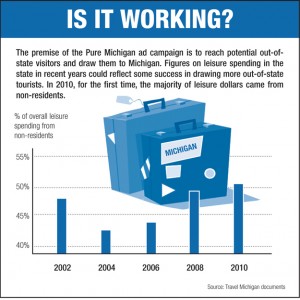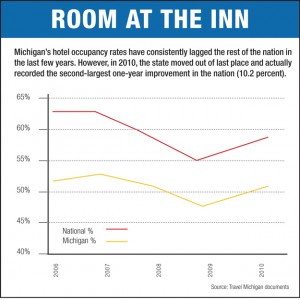Pure Michigan credited with $605 million gain
Pure Michigan. The sweeping lake vistas. The woods afire with autumnal splendor. The powdery snow covering a tranquil field. And over each image, the resonant voice of Tim Allen.
And behind these ads, the state of Michigan has spent $67 million since 2006 in a bid to draw more tourists -- and their dollars -- to the Great Lakes State.
Tourism officials and industry analysts say the campaign is paying big dividends for Michigan: 2 million visitors who wouldn't otherwise have visited, spending $605 million. And between 2009 and 2010, the tourism industry grew by $2 billion, enough to generate an additional 10,000 jobs for Michigan, they say.
By contrast, this summer, the state of Washington closed its tourism office, the victim of budget cutting that saw its finances drawn down from $10 million to $7 million to $1.8 million to nothing, reported the New York Times.
For the 2009-10 budget year, Michigan spent about $19 million promoting tourism. In 2010, visitors (tourists and business travelers) had direct spending of $17.2 billion, up $2 billion from the year before, though $1.5 billion less than the total from 2006.
 An annual survey of state tourism office budgets for 2009-10 placed Michigan sixth on spending, with the $19 million. For 2010-11, Michigan slipped to No. 7, even with a total budget of $27.4 million.
An annual survey of state tourism office budgets for 2009-10 placed Michigan sixth on spending, with the $19 million. For 2010-11, Michigan slipped to No. 7, even with a total budget of $27.4 million.
Travel Michigan, part of the Michigan Economic Development Corp., in conjunction with Longwoods International, a research firm specializing in advertising research and return on investment, has been conducting yearly studies assessing the impact Michigan's summer seasonal advertising on a national level and regional level since 2004. The focus of the study is to show the impact Michigan's advertising has on the perceptions of Michigan as a travel destination, the levels of travel generated by the advertising and the economic impact of the travel.
According to the 2010 study, the latest available, more than 2 million visitors who would not have traveled to Michigan otherwise spent $605 million statewide as a direct result of the $9.8 million Pure Michigan program. This research revealed that this new visitor spending generated $43 million in incremental state tax collections, creating a return on investment of $4.32 for each state dollar spent on tourism advertising.
Michigan is ranked No. 7 nationally in both total and leisure travel by the U.S. Travel Association.
 Coming ThursdaySo you've seen the Pure Michigan ads and all. But how does Michigan's effort stack up against tourism promotion in other states. Bridge Magazine reviews the national figures. |
Most of the Pure Michigan advertising is spent on television, radio and billboards. George Zimmermann, vice president of Travel Michigan, said, in 2010, that:
* Business travel rose 15.3 percent to $4.5 billion.
* Resident leisure travel rose 6.1 percent to $6.3 billion.
* And non-resident leisure travel -- the prime target for Pure Michigan ads -- rose 21.1 percent to $6.4 billion, the first time non-resident spending exceeded Michigan resident spending for leisure travel.
“Most Americans know Florida, California and Hawaii,” Zimmermann said. “We are just the opposite. We’ve only done a national campaign for just three years, with a modest budget. Michigan also is starting from a negative image of the Rust Belt, the depressed auto industry and urban decay in Detroit. The image of the state is much more favorable after visitors have seen the Pure Michigan ads."
Peter Yesawich of Ypartnership, a Florida advertising, marketing and promotions company, said he studies what states do to attract leisure travelers, and is impressed with the Pure Michigan effort.
“I think the Pure Michigan campaign has to rank among the most well-crafted and appropriate destination campaigns in the United States,” Yesawich said. “We focus on destination marketing. George Zimmermann is doing a terrific job, in a challenging economic environment, to make Michigan a summer seasonal destination.”
Rep. Frank Foster, R-Pellston and chairman of the House committee that oversees tourism policy, seems convinced:
"According to at least one study, Pure Michigan returns more than $2 in tax revenue for every $1 invested, making this a very successful program that takes pressure off future budgets. ... Our first priority in Michigan is revitalizing our economy and creating jobs. The Pure Michigan campaign attracts thousands of new tourists to Michigan, creating opportunities for local business owners such as restaurants, gas stations, hotels, bait shops, boat rental companies, and everything in between.
“The new funding model for Pure Michigan (from the 21st Century Jobs Fund),"
he added, "is a great improvement in that it is transparent and sustainable. I appreciate the governor’s approach to ensure that this program has a vibrant future, and look forward to the continued growth of the tourism industry in Michigan.”
 Michael LaFaive of the free-market Mackinac Center for Public Policy in Midland, however, is not convinced of the effectiveness, or legitimacy, of Pure Michigan.
Michael LaFaive of the free-market Mackinac Center for Public Policy in Midland, however, is not convinced of the effectiveness, or legitimacy, of Pure Michigan.
He questions the transparency of the Longwoods' analysis of the tourism campaign and is wary without seeing the methods behind such repeatedly positive outcomes. LaFaive says Longwoods does similar analyses for other states' programs and the return-on-investment results never seem to be negative.
LaFaive would prefer the state abandon the Pure Michigan campaign.
"I think it's just implausible that taxing away money from one group can create a net benefit for jobs and in terms of the treasury," he said. "In all likelihood we'll get back less than we give up. We have two decades of studies on our side that say that."
LaFaive reserves his biggest complaint for the Michigan tourism industry itself:
"If the industry is unwilling to pony up money for its own benefit, why should everyone else be forced to do so on their behalf?"
Zimmermann counters by noting some $3 million in private money flowed into the Pure Michigan ad campaign in 2011 from 30 tourism-related entities in the state. Two of the biggest contributors were the Henry Ford Museum in Dearborn and Mackinac Island, investing $500,000 each.
“Frankly, we’re not like Florida, we don’t have a Disney World that spends hundreds of millions of dollars marketing our state,” Zimmermann said. “But the $25 million for Pure Michigan dwarfs all funding from private sources. And if we didn’t do it, it wouldn’t get done and we wouldn’t create Michigan tourism jobs."
Zimmermann also defended the Longwoods report, citing positive reactions from major Longwoods clients such as consumer products giant Proctor & Gamble. What’s more, in 2007, the MEDC commissioned Michigan State University to do an analysis of Longwoods’ work. The MSU study put its stamp of approval on the research.
“Researchers are never comfortable drawing firm conclusions from limited observations, such as here when only comparisons could be made for a single year; however, the work we performed is strong evidence that Travel Michigan’s approach to estimating tax return ROI is valid,” the MSU report stated.
Dan McCole, who does research on the tourism industry as a professor at Michigan State University, said he thinks the Pure Michigan campaign has been very good for the state:
“People outside Michigan have a distorted image of what Michigan is. ... The campaign is well done. It connects with people. Taping into people’s emotions highlights Michigan in its best light."
See what new members are saying about why they donated to Bridge Michigan:
- “In order for this information to be accurate and unbiased it must be underwritten by its readers, not by special interests.” - Larry S.
- “Not many other media sources report on the topics Bridge does.” - Susan B.
- “Your journalism is outstanding and rare these days.” - Mark S.
If you want to ensure the future of nonpartisan, nonprofit Michigan journalism, please become a member today. You, too, will be asked why you donated and maybe we'll feature your quote next time!

